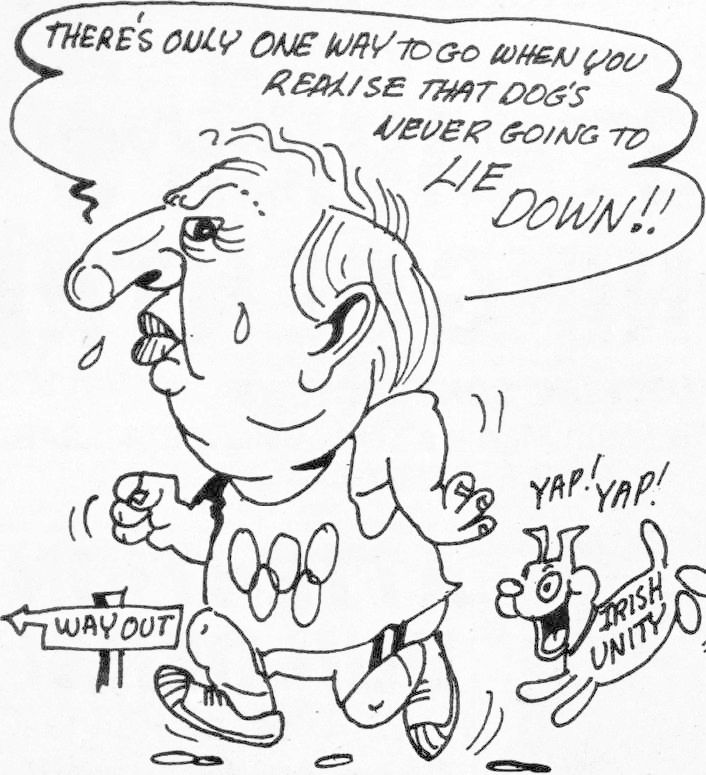We look at the stories that were making the headlines in the Andersonstown News this week back in 1984
Families hemmed in on the Ormeau during Twelfth parades
RESIDENTS of a nationalist estate on the Lower Ormeau Road have slammed the RUC for refusing to re-route the Twelfth parade away from the area.
This year again, six streets in the Lower Ormeau, including Artana, Hatfield, Balfour and Cooke Streets, were screened off on the Twelfth and local people prevented from leaving the area until Orange bands had passed by.
Now the local Lower Ormeau Residents’ Community Association have called for the parade to be re-routed along the Stranmillis Embarkment.
“The people of the Lower Ormeau Road want this annual parade of bigotry and intimidation to stop,” said a spokesperson.
However, previous please to the RUC for route changes have been unsuccessful.
“Over the years, several approaches have been made to the RUC to have the route changes, but they have refused to do so, arguing that they are always there to prevent trouble.
“They obviously forget the fact that while they are doing this, they cordon off our area, putting it under siege and preventing the residents of our area going about their normal business. They also ignore the tremendous tension and strain that these marches put on the residents of this area.”
This year two tenants’ associations in North Belfast responded to the annual cordoning of their areas to facilitate Orange parades by organising festivals.
Editorial: Revival of Irish the language
THE release of census figures in the 26 Counties this week, showing that more people in Ireland speak Irish today than did 100 years ago, will give some encouragement to all those working for the survival of Ireland's most important national characteristic.
Developed over a 2,000 year period, Irish is one of the oldest languages in Western Europe which reached its zenith with a golden age of knowledge and civilization when the majority of other countries in Europe lay in a dark age of ignorance and barbarism.
That such a rich heritage should be lost because of colonial oppression has concerned Irish people for centuries, and when the Irish Free State was set up, the restoration of the Irish language was a prime objective of the new state. The fact that over 1,000,000 people claim a working knowledge of the language today, says much for the dedication and enthusiasm of the teachers and educationalists in the early years.
The blame for that enthusiasm not making the state Irish speaking, or even bilingual, has to be laid at the door of the politicians who ran the state from its inception, but especially those of the last 20 years or so. The fact that the bulk of the Irish people still believe strongly in the revival of the Irish language, despite Fianna Fáil’s hypocrisy, Fine Gael's hostility and Labour's indifference, says much for their basic sense of patriotism.
But this goodwill towards the language is not sufficient to ensure its survival, and the people have to be shown more practical ways of helping the language. Given the lack of interest by political leaders and government bodies in general, the people themselves will have to band together to provide the infrastructure and institutions necessary for its survival, and in this day and age, a daily newspaper, a television service and an all-Irish education system are basic necessities without which no language can survive. These things are all people orientated and language activities no matter how learned and intellectual which are not geared to the people's needs, are worth nothing.
Because, as Seathún Ceitinn wrote in the 18th Century, "Ni hí an teanga a chuaigh ó chion ach an phobal dár dual a dídean."
SUMMER BREAK: Newcastle was smiles away for residents of Arundel House back in the summer of 1984
Save The Children staying put in Moyard
THE Save The Children Fund have confirmed this week that they will be staying put in Moyard.
Their announcement came in response to the expressed fears of local people who were under the impression that the scheme was to be axed – a fate which has befallen two pre-school playgroups in the Upper Springfield area over the last year.
A spokesperson for Save The Children told the Andersonstown News: “There is no way we will be leaving Moyard. We may move into new premises in the estate next year to facilitate a Housing Executive development but we will not be going away.”
The spokesperson said the Moyard scheme which is based in a mobile hut would remain on the estate as long as DHSSB funding was forthcoming – “and that would be for the next five years at least.”
Ciarán de Baróid, a community worker in the Upper Springfield area said the facilities for pre-school age children were “abominable”.
“In recent times an RSPCC scheme in the Ballymurphy Tenants’ Association Centre and a Save The Children scheme in Springhill were stopped, causing much distress to local parents,” he said.
According to Mr Baróid there are children in the greater Ballymurphy area eligible for pre-school playground facilities but only 100 of this number could be catered for by the area’s two main nursery schools. Another 100 in all were attending the schemes in Moyard, Ballymurphy Road and the New Whiterock Community Centre.
‘This, he said, left 350 children who weren’t being catered for at all. There are, also,” he community worker said, “230 toddlers who have no facilities whatsoever.






